20 November, 1998
Friday, November 20th, 1998
Hi! Before I get started, some of you have been wondering how you can print
out my journals and not have part of it cut off on the side. Print it in
"landscape" format, meaning horizontally, not vertically, and you should be
fine. Second, some people have been saying that the TEA e-mail link doesn't
always work for them…use my home
e-mail address: BOOP82@aol.com because I check it several times a day.
Thanks!
Now…I just don't know WHERE to start…this was an INCREDIBLE day! I got to the
lab early and worked on labeling the samples from yesterday. I wanted to get
this finished, because Fred Atwood, one of the other TEA teachers down in
Antarctica, and I were going to take Skidoos and ride out to Big
Razorback…where they are studying seals. Dressed in full ECW gear, we
proceeded to ready the Skidoos and leave McMurdo. We didn't get too far when
Fred's Skidoo stalled and after several attempts to get it started, we had to
give it up. We got out the repair directions, and checked the fuel lines and
what little else we knew, but nothing seemed to help. Fred radioed Mac Ops
and informed them of our predicament and we waited while they patched us
through to the Skidoo shop. As we waited for someone to come out to give us
assistance, I was able to start the Skidoo and we headed back to Mactown….very
disappointed. In the meantime we had contacted the camp at Big Razorback and
they wanted us to reschedule the trip for sometime next week. Things that
made this failed attempt worthwhile…getting a short ride on a Skidoo in the
FRESH air, and seeing two seals up close, right near where the Skidoos are
left on the ice. Maybe next week…
At lunch I saw Elissa Elliott, another TEA teacher, who is leaving McMurdo to
fly home to Minnesota tomorrow. We spent a lot of time together in
Christchurch, but most recently she has been in the Dry Valleys with her
science team. Be sure to check out the journals of the other TEA teachers. We
all have a lot to share.
I spent some time in the computer lab trying to catch up on all of my e-mail
and journals before leaving town tonight. While in the lab, the fire alarm
went off and we had to file out of the building. It turned out to be a false
alarm, but the fire truck arrive and they treated it like the real thing. I
had this tremendous urge to tell everyone to stay in line and stop
talking…like at school when we have a fire drill! I was in my teacher mode!
One thing that was important was that the firemen thanked everyone for
"treating this alarm with a healthy respect" instead of goofing around. You
never know when it could be the real thing.
Fabio and I drilled only 17 samples today. The core was full of large and
small pebbles. I helped back in the lab with the MOLSPIN demag machine, and
before I knew it, I was having an early dinner. This is where my DAY really
got a jump start. I hurried back to the lab….put on the ECW gear AGAIN, and
ran down to the helicopter hangar by 6:00 PM. I was finally going to the Cape
Roberts camp and drill site. My very first helicopter ride…ever…and what a
place to have one!
We had to weigh ourselves and our gear and report this total so that a final
total could be tallied up and added to the weight of the cargo that was going
on board the HELO. Yes Michele, I told the truth. Ha Ha! We picked out
helmets, which reminded me of something out of Star Wars…white with black
trim…built in headphones and a mike to talk into. You'll see one in the
photos later on. At that point it was a waiting game..the HELO had to arrive
back in McMurdo with some DV's (distinguished visitors) before we could depart
for Cape Roberts. Soon we could hear the steady beat of the chopper heading
toward town, and it wasn't long before the red and white National Science
Foundation, Bell 212 (civilian version of the Huey) came into view.
Matt Curren, Sandra Passchier, Jaap Van Der Meer, Marco Taviani, and Pietro
Armienti, and I were the passengers on board tonight. We really had to
squeeze into the back of the HELO to fit…there was some cargo in our seating
area as well. With helmets on and plugged in so that we could hear what was
being said by the pilot and everyone else (and talk ourselves), and seat belts
buckled…we were airborne about 7:30 PM. I hardly even noticed the lift off,
except for the blowing dust and sound of the propellers. It was very smooth.
Even when cruising along, the vibrations were less noticeable than I had
imagined.
Views were unbelieveable…we had a very clear, crisp evening to fly. Mactown
became a distant speck on the horizon very quickly, and the surrounding
landscape was sea ice, Mt. Erebus, the Trans Antarctic Mountains, seals,
icebergs, and the open water. THAT was neat to see after all the days of ice
and snow….open water. It was pretty far off in the distance, but absolutely
visible…I kept thinking of penguins just off shore. I wish we could have
taken a slight detour along the way! One thing that is important to mention
is that things look so much closer than they actually are…that is quite
deceiving. Mountains look close, but as you fly along, you realize that they
are much farther away.
We had to touch down at Marble Point Air Facility to drop off a little bit of
cargo, and this took only 5 minutes, tops. Still, it was fun to land and take
off again. The landing was so smooth….if I had closed my eyes, I doubt I
would have felt it…these pilots are good! When we were back in the air, we
started to see HUGE icebergs….frozen in the sea ice at the end of the summer
last year…as they were floating away from the land. These chunks of ice had
broken free from glaciers…but had not made it too far. Soon the Cape Roberts
field camp came into view and we circled in to land just beyond the camp
boundary.
Our landing signaled the start of the second shift for workers at the drill
site…15 kilometers (about 9 miles) away. Men and women bound for the drill
site boarded the HELO and were whisked off to work. How would you like to
travel by helicopter to work each day? The HELO had to make three trips back
and forth from the camp to the drill site. As it returned to camp every 15
minutes or so, it brought with it the men and women from the first shift out
at the drill site. A nice shuttle arrangement! On the last trip back, the
HELO was loaded with passengers and the padded core sample boxes that are used
to transport the core back and forth from the drill site and to McMurdo.
These were unloaded and quickly cargo was put ON the HELO to go back to
Mactown. Most of this cargo was trash, but there was also new core going back
to Crary Lab.
One of the first things I saw when I walked toward the "buildings" of the
camp, was a sign that read: "Cape Roberts County…Welcome to Cape Roberts…It
may not happen today, but it will happen." This is a result of the project
two years ago, when it had to be scrapped for the season because of poor sea
ice conditions. Since this sign was used last year…there were various
population figures, crossed out, with new notations made…this indicated how
many people were living at the camp at different times during the short
drilling season last year. You could see how the population dwindled when
they had to rapidly close down the drilling and vacate the area. The
population of the camp this year hovers at around 40 people.
Jim Cowie, the Project Manager, gave us the tour of the "camp." I've got to
describe this place to you. Most of the "buildings" are in reality, second-
hand refrigerator shipping containers used on ships. Jim purchased them at a
very reasonable price. Think about it…they are being used in REVERSE of what
their intended use was. Originally they were used to keep things cold on a
ship-now they are used to keep us warm in the cold icebox of Antarctica. Even
our little "dorm" was a container. The only part of the camp that wasn't made
of containers was a double length (two put together) Jamesway. One section
served as the dining room, and the other as a gathering place for music, TV
and movies, and a place to hang out. They called that section the "Bat Cave
Café & Bar." Great smells were coming from the kitchen, as many of the first-
shifters were eating dinner. Michele offered me some fried scallops…quite a
treat. I also had a FRESH SALAD for the first time in weeks. It was great to
have lettuce, red and green pepper, green onions, cucumber, and celery. They
also had lots of fresh fruit at the camp.
As Jim gave us the tour around, he pointed out important features like the
showers (no two minute limit here), the desalination plant (where they pump up
sea water and remove all salt from it), and the power plant. The desalination
plant pumps up 2,000 liters of water a day and there is 5,000 liters in
storage. They do a daily PH test, weekly tests for bacterial growth, and
during the season they test 2 times and send the samples to New Zealand for a
full screen. There are two fuel-powered generators in the power plant…one
always working and one on stand by. Jim was telling me that the Cape Roberts
camp is primarily a "single fuel camp." This means that they use JP-5 fuel
(almost like kerosene) for practically everything, except the Skidoos (which
use MOGAS-motor gas).
Next stop was the core lab where they process the core and describe it for the
scientists back at Crary Lab. I got to meet Ross Powell, who I had heard
about, since he teaches at Northern Illinois University…close to me. He has
agreed to come visit Husmann when I get back, which will be great! He can give
so much information about the Cape Roberts project and camp that I cannot.
He's been at the camp since before the drilling started. What a great
resource for me to have close by! Ross and Michele showed us what they do
with the core when it comes to them from the drill site.
Our little party of visitors found out that we were going to be treated to a
tour of the "countryside" by Ross at 9:30 PM. Everyone started out on a hike
to the top of a hill (ice sheet) nearby that has a repeater on it. A repeater
is set up to relay messages by radio. It is located on a high point to avoid
interference. The radio signal is sent to it, and the message is recorded
digitally. A few seconds later it "repeats" the message to the next radio
station or repeater. In this case, it repeats the message to McMurdo directly
to the Mac Ops office.
The hike began with a slow walk across a flat section of sea ice. It was a
slow hike in all of that heavy ECW gear and carrying two cameras! Matt and I
kind of hung near the back and trudged along with Marco bringing up the rear.
Marco is making the most wonderful professional film of the whole Cape Roberts
project and his experiences. He was always stopping to film, take photos or
digital pictures. We were up the hill and he was still climbing-we were
practiclly down the hill and he was up filming. It paid off though, because
later we watched his video footage back at the camp and it was awesome!
When we reached the top of the hill and the repeater, we were rewarded by
superb views of the surrounding area…I'd say for about 270 degrees. We could
see the icebergs below, the Mackay Glacier meeting Granite Harbor, Mt. Erebus
(miles and miles away), the land of Cape Roberts jutting out into the sea ice,
and the Cape Roberts camp below. What a beautiful sight! The blowing snow
was coming gently over the top of this huge hill. Matt said they were called
"snow snakes" and I liked that analogy a lot. The wisps of snow did "snake"
their way across the hard packed snow and drifts. Thanks Matt for the new
phrase!
We stayed up on the hill for awhile, visiting and watching Marco filming. The
hike back down was SO much easier. The bunny boots are just not meant for
climbing. During the flat part of the hike, we were walking across blue sea
ice, snow pack, and softer drifts. The patterns and shadows were very
interesting. As soon as we arrived back at camp (at 11:30 PM), we found three
snowmobiles (two with little wagons attached to the back) and we jumped on
these and drove off to see some icebergs up close. I drove one Skidoo, Sandra
drove one with Matt and Jaap in the wagon in back, and Ross drove the third
one with Marco and Pietro in the wagon (in front of me). Watching those guys
ride in the wagons was a hoot. They bumped along and tried to take pictures
and film… actually Marco's movies turned out pretty good, considering.
Our first stop was a pair of HUGE icebergs. Engines were stopped and we
stared in awe at these massive pieces of ice…trapped temporarily in the sea
ice. I took TONS of photos…of course. The "tour" covered several iceberg
sites. At our second stop we hiked back into an area where the icebergs came
in many shapes and sizes. There were tons of piles of ice (like a bunch of
ice cubes laying in a pile). I watched as Ross, Matt, Sandra, and Jaap
climbed up the side of an iceberg that had fallen over. You could see the
water line. The bottom of the iceberg was now exposed and its top was
slanted.
Eventually we HAD to head back to the Cape Roberts camp…and we arrived "home"
at about 1:30 AM. It was hard to turn away from the splendor of these
incredible icebergs and we were reluctant to do so. But…it was getting late.
After arriving back at the Jamesway, we had a midnight snack-well, long after
midnight. We munched on cheese, summer sausage, crackers, fruit, and lots of
water to re-hydrate ourselves! Kath, the second shift cook, brought out some
fresh sweet roll in a loaf (like bread). It was still warm and quite yummy!
I think I could get used to the food here!!!
Finally, we gave in and went to our "freezers" to sleep. Sandra and I had our
own little (and it was little) container with four bunks in it. Thank
goodness there were only two of us….I don't know how four people would fit in
there with all of their stuff. On each bunk was a down sleeping bag…well, not
really a bag, more like a sack. It had NO zipper so I had to wiggle down
inside of it. Actually it was very warm and our container had a little heater
in it as well. I slept fine…just not long enough.
There's a lot more to tell you about tomorrow, so make sure you read that
journal, too! Talk to you then.
Betty :)
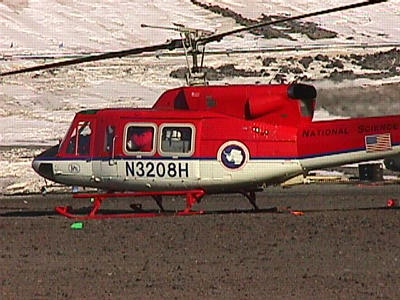
As the HELO arrived in McMurdo, we prepared to board for our take off and trip to Cape Roberts. For me, this was an exciting moment...I had never been in a helico pter before!
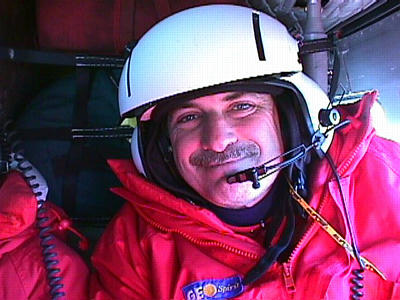
Marco was sitting directly across from me, filming, as we flew to Cape Roberts. I thought he looked better in the helmet than I did.
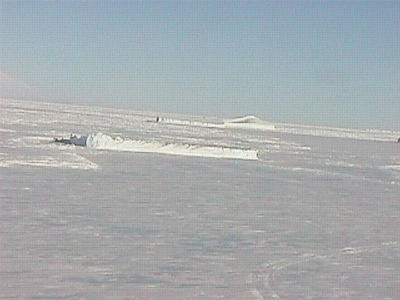
I enjoyed the super views as we approached Cape Roberts and the icebergs.
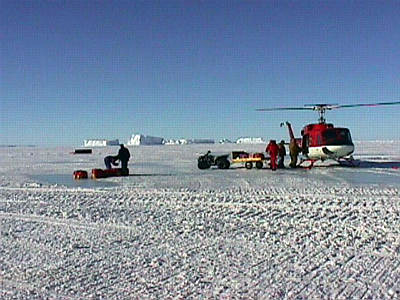
As the helicopter was unloaded, I stood around to watch the process. Notice the icebergs in the background.
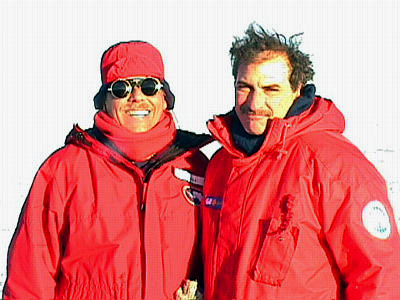
Thanks to Ross Powell (left) for a great night of hiking and Skidooing to the icebergs, and Marco, for the constant entertainment! You guys are great!

This is the repeater on the top of the hill near Cape Roberts camp. The signal is "repeated" or transferred to McMurdo from here.

This was our "dorm" for the night...a second-hand refrigerator shipping container. Quite nice, actually...and warm!

Thanks to Marco, who took this photo of me on the Skidoo adventure to the icebergs. It was a GREAT night all around!
Contact the TEA in the field at
.
If you cannot connect through your browser, copy the
TEA's e-mail address in the "To:" line of
your favorite e-mail package.
|
